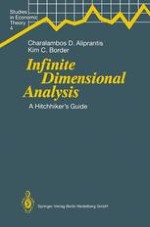This text was born out of an advanced mathematical economics seminar at Caltech in 1989-90. We realized that the typical graduate student in mathematical economics has to be familiar with a vast amount of material that spans several traditional fields in mathematics. Much of the mate rial appears only in esoteric research monographs that are designed for specialists, not for the sort of generalist that our students need be. We hope that in a small way this text will make the material here accessible to a much broader audience. While our motivation is to present and orga nize the analytical foundations underlying modern economics and finance, this is a book of mathematics, not of economics. We mention applications to economics but present very few of them. They are there to convince economists that the material has so me relevance and to let mathematicians know that there are areas of application for these results. We feel that this text could be used for a course in analysis that would benefit math ematicians, engineers, and scientists. Most of the material we present is available elsewhere, but is scattered throughout a variety of sources and occasionally buried in obscurity. Some of our results are original (or more likely, independent rediscoveries). We have included some material that we cannot honestly say is neces sary to understand modern economic theory, but may yet prove useful in future research.
